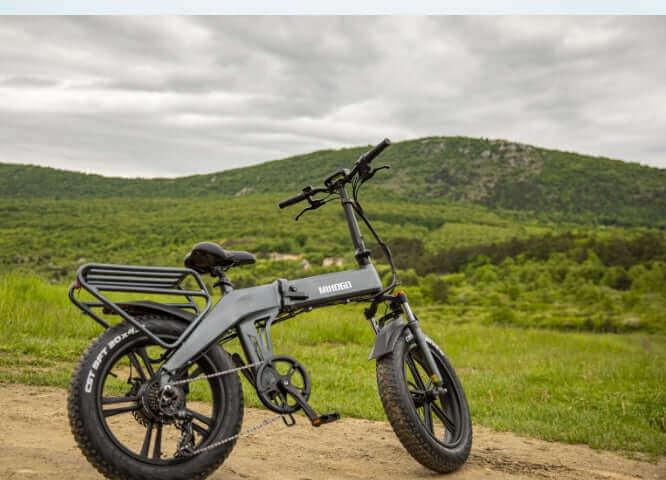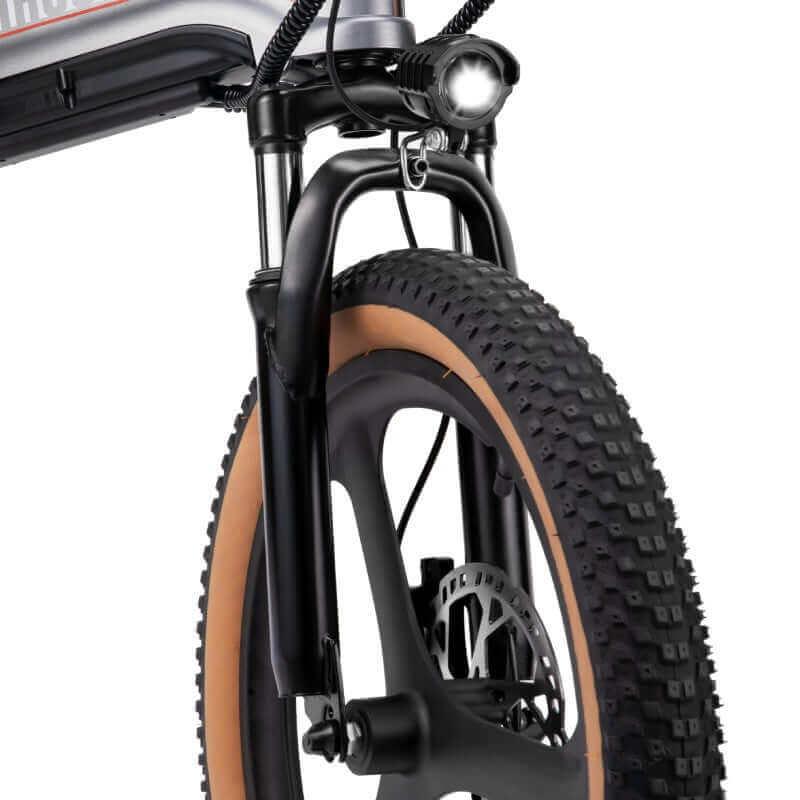1. Introduction: What is an Electric Bike?
Before we dive into how to find your ideal electric bike frame, let's first understand what an electric bike, or e-bike, is. An electric bike is a bicycle with an integrated electric motor that assists riders with pedaling. E-bikes are a fantastic transportation solution, offering increased speed, decreased exertion, and a more enjoyable riding experience. With a wide variety of small e-bikes, big and tall electric bikes, and everything in between, there's an e-bike out there for everyone.
2. Understanding the Basics: E-Bike Frame and Bike Computer Feet
The frame is the backbone of your e-bike, influencing how it handles and fits your body. The e-bike frame size determines your comfort and safety while riding. Generally, frames are measured in inches or centimeters, depending on your location. The "bike computer feet" refers to the display on your e-bike that shows important metrics like speed, distance, and battery life.

3. Standover Height: A Crucial Measurement
The standover height is the distance from the ground to the top of the bike's top tube. You'll want to be able to stand over your bike comfortably with both feet flat on the ground. The bike standover height is especially crucial for women's electric bikes and those designed for shorter riders.
Take a journey into the electric biking landscape and become acquainted with the crucial metric known as 'standover height'. This metric signifies the vertical distance from the ground to the uppermost tube of your e-bike. Don't stress if the actual bike is not immediately accessible. You'll find most manufacturers provide the standover height information in their online product descriptions.
The application of this measure? Gauge it against your own inseam length to ensure you can solidly touch the ground with your feet while straddling the bike. Aiming for an approximate clearance of an inch above the top tube, your bike's peak point, is a sound rule of thumb. An inability to firmly plant your feet indicates that the bike's standover height is excessively large for you, suggesting that a shorter model would be a more fitting choice.
A common misunderstanding among new riders is that both feet should be able to touch the ground while seated on the e-bike. This isn't the case, however. Continue reading to gain deeper insights into finding the optimal seating position tailored just for you!
4. Seat Height: Ensuring Comfort and Proper Leg Extension
Bicycle seat height is another critical measurement, and it's important to understand how tall your bike seat should be. A seat that's too high or low can lead to discomfort and inefficient pedaling. A rough guide is that your leg should be slightly bent when your foot is at the bottom of the pedal stroke, ensuring proper leg extension on bike.
Once the safe standover of the e-bike is ascertained, the next crucial point of consideration is the height of the bike seat, or as commonly known, the saddle height. Several straightforward techniques exist to find your perfect seat height. If you have the opportunity to inspect the e-bike physically, the heel-toe method serves as an effective guide:
- Rotate the bike's crank, positioning the pedal under your heel in the downward position, so that the crank arm aligns parallel to the seat tube.
- Check if your leg fully extends with your heel on the pedal in this position while seated. If it does, your seat is placed too high.
- Rocking hips in order for your heel to reach the pedal implies a high seat placement.
- A significant bend at the knee when the heel rests on the pedal in the downward position indicates a low seat.
- If you intend to engage more in pedaling than throttle usage, ascertain the correct saddle position with your foot at the pedal's lowest stroke - an ideal scenario would present a slight leg bend, amounting to 80 – 90% of full leg extension.
When assessing the e-bike, confirm your ability to smoothly swing your leg over the top tube and seat. Any discomfort or resistance might suggest a step-through frame e-bike as a better option.
Online shoppers without the chance of a physical trial can also find their perfect saddle height through a few mathematical means, devoid of complex physics:
Hamley Method: Multiply your inseam (measured in inches) by 1.09 for your suggested seat height.
LeMond Method: Multiply your inseam (once more, in inches) by 0.883 to find the recommended span from the top of your bike seat to the center of the bottom bracket.
If calculations aren't your forte, numerous online calculators will shoulder this task, ensuring your ideal bike seat height. Once your saddle height is established, the next check is for the 'reach,' essentially how effortlessly your hands find the handlebars, ensuring an ideal fit.
Finding the Ideal Reach
Your target should be a riding stance where your arms exhibit a slight flex but don't stretch excessively to reach the brakes. A simple test to determine the right reach is to imagine playing a piano on your handlebar — if your fingers can glide effortlessly over the imaginary keys, then you've nailed the perfect riding position!
For those who are in the market for an e-bike online, analyzing the bike's top tube length can aid in establishing the best reach. Larger frames yield a longer top tube on e-bikes, whereas smaller frames sport a shorter top tube. A compact top tube enables a more relaxed reach on e-bikes featuring an upright seating position, as it brings the seat and handlebars closer together.
5. Body Measurements: Inseam, Height, and More
When sizing an e-bike, personal measurements are crucial. Two key factors are your overall height and inseam (the length of your inner leg).
For example, if you're wondering what your size might be if you're 185cm to inches tall, the conversion is approximately 73 inches. Similarly, 152cm to inches equates to about 60 inches. It's worth noting that a 5'3 and 5'10 height difference or a 5'0 and 5'10 height difference can significantly affect which bike size you need. Therefore, knowing how to calculate these measurements (like 5ft 4inch in cm or 168cm inches) is essential.
6. Size Charts: Decoding the Numbers
Most manufacturers provide a sizing chart to help customers find the right fit. The electric bike size chart or motorcycle size chart height typically correlate frame size to rider height and inseam. For example, if you're a motorcycle seat height for 5'3 woman, the chart will guide you to the appropriate bike. Similarly, charts like the Haibike size chart, Trek Verve 3 size chart, or fat tire bike size chart help you match bike model to your measurements.


7. Bike Variations: From Small Frame Electric Bikes to XL E-Bikes
E-bikes come in a range of sizes, from small frame electric bikes perfect for petite riders, through to xl ebike models that accommodate taller individuals. There are small electric bikes for adults, as well as large electric bike options for those needing a bigger frame. Companies are increasingly accommodating diverse body types, with options like electric bike for plus size riders, electric bike for short person, and big and tall electric bikes.
8. Women vs. Men: Does Gender Matter in E-Bike Sizing?
In many cases, women and men can ride the same size bike, as long as it's the right fit for their height and body type. However, manufacturers often design specific women's electric bikes and men's electric bikes that accommodate typical body differences between genders. There are plenty of ladies e bikes, women's electric bicycles, women's electric road bike, and best ebikes for women on the market.
9. Conclusion: Your Perfect E-Bike Size is Out There
Finding the right e-bike size isn't just about comfort—it's also about safety, efficiency, and overall enjoyment. By understanding crucial measurements like standover height, seat height, and your personal measurements, you can confidently choose the perfect e-bike size. Whether you're looking for a small e-bike, xl electric bike, or something in between, there's an e-bike out there that's the perfect fit for you.
For additional help on finding your perfect e-bike size, check out these resources: How to Choose an Electric Bike, eBike Sizes, and HOW TO CORRECTLY SIZE YOUR ELECTRIC BIKE.
To further expand your knowledge on the subject, you can also explore this comprehensive Buyer's Guide To Electric Bicycles! Happy riding!









1 commento
The photo linked in the main blog to this page shows a Mihogo Mini. Can the Mini accept standard diameter long seatpots to adjust for people over 6’ tall with 34+" inseams?